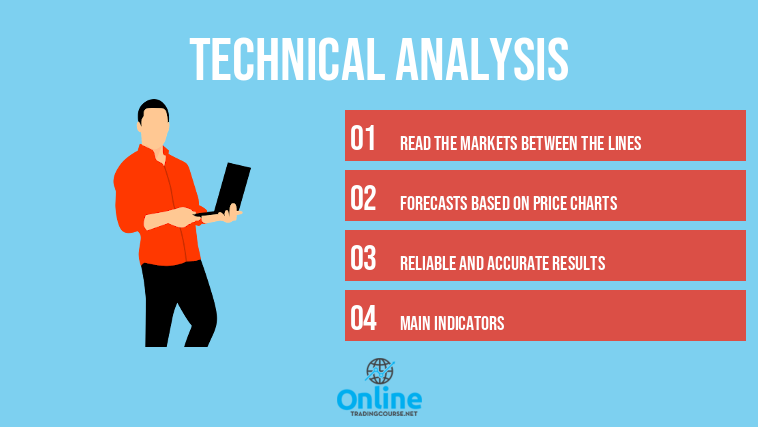
Technical Analysis
What does the Technical Analysis consist of? Why is it so important for trading? How can you increase your earnings through it? If you are looking for an answer to these questions you are really in the right place.
This is the most complete introductory guide on the web for the topic of technical analysis of financial markets. Let’s talk about the most important discipline for studying the prices of goods, securities, cryptocurrencies and any other asset in circulation.
For decades, online trading professionals have used technical analysis to steal the secrets of market trends. The best of them manage to reach incredibly high profit heights and boast excellent negotiating skills.
Thanks to the power of technical analysis, people like Warren Buffett (a true legend of the markets) has earned the nickname of the Oracle of Omaha. This nickname was given to him precisely because, with the help of technical analysis, Mr. Buffett was able to make market forecasts that no one else could ever have imagined.
This powerful means of investment is now available to all traders thanks to the best online trading platforms. Here on OnlineTradingCourse.net you have the opportunity to learn how to do technical analysis, so don’t miss the rest of this introductory guide and learn the basics of the subject and then deepen the discussion in the other pages of our portal.
Before continuing, it should be noted that thanks to the eToro platform it is possible to copy, in a completely automatic way, what the best traders in the world do.
This allows beginners to get the same results as the best traders, even before learning trading. Indeed, watching what the best traders in the world are doing in real time is a smart way to learn how to trade.
You can sign up for free on eToro by clicking hereIndex
Technical Analysis: reading the market
Before continuing, better clarify a concept immediately. There is no analysis technique and no trading strategy that can make a trader earn 100% of the time. Trading online is a form of investment like any other and therefore exposes you to the risk that your operations may go wrong.
However, the point is that with the help of a good technical analysis the trader is able to trace a route to follow. This route in most cases leads to profit, but only on condition that all the calculations and the necessary preparations have been made well to arrive at the result.
Have you ever wondered why it seems that most of those who trade online lose? The reason is very simple: they have a tendency to do operations without following any criteria, without having any operational plans. The pattern followed by most losing traders is always the same: hitting the buttons on the platform at random in the hope of making a profit.
It goes without saying that no one has ever earned anything by behaving this way. If you do not follow a trading strategy, if you do not carry out preliminary analysis that anticipate market operations, trading turns into a race at 100 hours along a road immersed in the fog.
What traders of this type don’t realize is that the fog hides a wall and sooner or later you end up on it and end of the race. To make money with trading you need a different attitude, you need a strategic, prepared and success-oriented attitude. All this can be guaranteed also and above all by the use of technical analysis to read behind the lines of the markets.
Technical Analysis: meaning and functions
After this introduction aimed at emphasizing the importance of using technical analysis, we come to talk about this discipline in more detail. First of all, it is necessary to clearly define what technical analysis is.
The term technical analysis defines the activity of studying the price charts of market assets. By asset we mean any asset, security, commodity, currency or cryptocurrency that can now be traded in the context of online trading.
Those who are technical analysts (also called chartists, from charts or graphs) therefore analyze the historical price trend shown by the charts on specialized trading platforms and sites. The study of past data allows the trader to make predictions on the future price trend with excellent accuracy.
It is thanks to the conclusions drawn during the technical analysis that the trader later decides which strategy to use to make money by investing in this or that financial asset. In particular, you can decide to:
- Open a buy position in case the price is rising
- Open a sell position in case the price is falling
Theoretical basis of technical analysis
Technical analysis can be conceived as a real science and as such it is reliable. Its theoretical foundations, without going into technical details, had been dictated by Charles Dow. For this reason still today we talk about Dow’s Theory, a man who in his own way and in his time laid the foundations of technical analysis.
Here are the 6 basic foundations of technical analysis as established by Charles Dow:
1 – The 3 Phases of the markets
The 3 main market phases according to Dow are primary, secondary and minor trends. – The primary trend is a larger trend that lasts more than a year.
– The secondary trend is an intermediate-duration trend that can range from a three-week to a three-month period. The secondary trend often moves in the opposite direction to the primary trend.
– Finally, the minor trend of a market has a duration of less than 3 weeks and can be associated with the movements of the secondary trend.
2 – Trend phases
The second principle of the Dow Theory explains that market trends have and follow 3 different phases. The 3 types of trend phases are called accumulation, speculation and distribution. The last phase, distribution, is called the excess phase in a bull market and the panic phase in a bear market. Trend phases can be generated by market movers).
3 – The market is affected by news
The third principle establishes the strength of the news towards the market. Dow was the first to theorize that the market is strongly affected by all the news concerning it and moves in the wake of the impact that the news has had. This means that any market (commodities, Forex, stocks, etc.) discounts all news concerning it as soon as they are released (to know the news, it is good to consult the economic calendar).
4 – The market indices are confirmed
Dow argued that stock market indices, must be correlated as having the same exposure under current economic conditions. For example, the Dow Jones must have a correlation with the Dow Jones Transportation Index. If there is any kind of divergence, Dow argues that there will be a trend change on one of the indices, so it is difficult to predict where this new primary trend will start or if it will develop. If, on the other hand, there is a correlation, then a confirmation of the trend is generated.
5 – Trends are confirmed by volumes
When we talk about volumes we refer to the amount of money invested at a given time in a market. The increase or decrease in volumes is a very important indicator on the markets. If large volumes accompany the formation of an upward or downward trend, this is a strong and positive signal on the continuation of that trend. If we are in the presence of low volumes, however, the trend may still be valid, but it is not representative of an overview.
6 – The trend continues until reversal
Trend reversals are the worst enemy of any trader within a trade. You have to recognize them immediately to get out of your position promptly and take home the profit. However, the sixth and final Dow Principle states that a trend remains confirmed until there is irrefutable evidence to the contrary. That is, all the necessary analyzes must be done before establishing whether the trend is over or not.
Read also: Bollinger Bands
Technical Analysis: too difficult?
Given what we have mentioned so far regarding technical analysis, a question may arise spontaneously: is it too difficult a discipline for beginners? Doing technical analysis is far from impossible. Of course we are not talking about a very simple thing, but even a novice trader can easily do it.
The most important thing for those who want to trade on the financial markets is the practice, especially the practice of technical analysis. It doesn’t take too long to learn how to use the basic tools for analysis. It takes about a week to be able to master the main trading tools available on all trading platforms.
In fact, technical analysis is done through the so-called “technical indicators” or that series of models and charts that help the trader make decisions on the market. With technical trading indicators you receive a lot of data and indications on how and where it is really convenient to invest on your own.
On the main trading platforms it is possible to operate even just by observing the simplest indicators and leaving them with the default settings. Later, when more experience has been gained, the trader can also decide to modify the basic settings to customize the operations. But this is to be postponed to the moment when you are really ready to manage it in a conscious way.
Our advice is to focus on learning and using only one indicator at a time, starting with the simplest ones such as the “simple moving average“, which is already a powerful tool, although very easy to use.
For those who want to learn (well) technical analysis, we recommend downloading the ForexTB book for free. This is a course that had a tremendous success in Europe, with hundreds of thousands of downloads.
This success is due to the fact that it is free, while other courses are paid and cost a lot, and to the fact that it is really useful because it explains in practice how you make money with trading, without difficult words and without wasting time with theory.
You can download the ForexTB course for free by clicking hereThe two main school of thought
Among those who use technical analysis as the main source of data to operate on the markets, two main currents can be distinguished: theoretical analysts and practical analysts. We distinguish between the two approaches by indicating which attitudes are right and which are wrong according to our experience, the team of OnlineTradingCourse.net.
Theoretical technical analysts represent that kind of perfectionist traders. They spend their time analyzing down to the smallest and most insignificant market movement in the belief that they can predict and understand whatever is happening on the price. The theoretical analyst is almost never satisfied with the results of his analyzes and continues to extend them over time to the point of risking losing important trading opportunities.
Generally speaking, it can be said that the less experience you have in trading, the more you tend to be “theoretical analysts”. For us this type of approach to trading is counterproductive because it is dictated by the fear of making mistakes. Perfectionism in trading doesn’t pay. Better to spend hours on the demo account making mistakes in the market readings and in the settings on the platform, rather than living eternally waiting for the presumed right conditions to operate.
The other current is that of practical technical analysts. This is the type of trader who, once objective data has been collected from the indicators, does not hesitate even for a moment and opens a market position. This is an attitude that especially those with good experience on the markets take. In any case, this is the right attitude, the winning one, especially in the long term.
The operational principles of the practical analyst are only 2:
- Enter the market as soon as a trend is individuated
- Avoid trading when the market is on the sideway
In the end, the rules for success in the investment phase, as you can see, are not difficult to follow. Furthermore, it should be noted that the simpler, clearer and more direct they are, the easier they are to follow.
Read also: Invest in the Stock Market.
Becoming a Practical Analyst: the demo account
Do you want to become a practical analyst too? Well, then know that there is a tool that can do for you and that is offered free of charge to all new members on the online trading platforms: the demo account.
The demo account is a trading account designed only to practice and therefore understand how trading and the financial markets work. As we have seen, practice is essential to become trading masters and always be able to read the various market situations, so using the demo account is really crucial.
Especially for learning technical analysis, the demo account is the ideal tool because it places the trader in front of price charts in real time with the ability to open and close positions based on their own analysis at any time. All this can be done without fear of making a mistake, because the demo account contains only virtual money and therefore losing it does not cause any problems, it is only for practice.
Below is a list of the best online trading platforms that offer free demo accounts:

|
Platform: etoro Min. Deposit: 50€ License: Cysec |
|
|
|---|---|---|---|

|
Platform: xtb Min. Deposit: 100€ License: Cysec |
|
|

|
Platform: iqoption Min. Deposit: 50€ License: Cysec |
|
|

|
Platform: ubrokers Min. Deposit: 250€ License: Cysec |
|
|

|
Platform: trade Min. Deposit: 100€ License: Cysec |
|
72.30% of retail CFD accounts lose money
|

|
Platform: forextb Min. Deposit: 250€ License: Cysec |
|
|
Technical Analysis: price charts
Let’s now go into detail on that element that is the basis of technical analysis, which represents its soul and fulcrum: the price charts. When trading, the activity takes place almost entirely on specialized trading platforms and able to offer price charts in real time.
If this is the case, it is obvious that every operator must necessarily specialize as much as possible in the ability to read graphs and must know everything about them. Charts are great because they contain virtually all the information a trader needs to be successful in investing on their own.
Almost every single symbol or formation that is created on a price chart has a meaning and offers the trader information that he can exploit to his advantage. Regardless of the market in which you operate, price charts are always important. Whether you like investing in equities, Forex, cryptocurrencies or commodities makes no difference.
Read also: Pivot Point.
Price Charts: how do they work?
Each of us at least once in a while watches the news. Very often in the course of the broadcast we also talk about finance and markets and for this reason the price charts of some financial asset or title are also shown. Charts are still used today because they represent a maximum simplification of the price trend and make it immediately readable.
Of course, for those who have never seen one, the signs on the graphs could also seem like meaningless lines, indeed for someone they could just look like hieroglyphs. But these signs are actually gold for all financial traders. The charts show the past of the price and their trend can also express what will happen in the future.
On a chart, what you look at is nothing more than the graphic representation of the price, but always within a specific time frame. To get an idea of how a graph is made, you can look at the image below.

This chart shows the situation of IBM shares in the last 5 years. In this case, what you are looking at is a linear chart, which is composed only of one line. A chartist looking at this chart can immediately tell if the market is trending and can get an idea of its volatility.
The 3 types of charts for technical analysis
In any form of online trading there are only 3 main chart types and these are:
- Candlesticks or Japanese Candlesticks
- Bar charts
- Line charts
These three types of charts can be interchanged at will on all the best trading platforms. Sometimes changing the type of graph is used to receive information that cannot be obtained on the other type and vice versa, but it is above all professionals who know how and when to change graphs.
In addition to the X and Y axis which represent the basic elements of each graph being the space and time variables, there are two other fundamental elements that characterize a graph:
- The Time Frame: it is the specific time frame at which we want the chart to record price changes. In simpler words, a daily time frame will show the prices of the financial instrument under examination on a daily basis, an hourly time frame will instead show on an hourly basis and so on. There are also monthly and yearly time frames.
- Volume: volume is the total number of trades during a given period of time. Usually this is a trading day, but depending on the time frame you set to analyze a chart you can observe the trading volume at 1, 5, 15, 30, 60 minutes and so on. The greater the number of trades, the greater the volume. By observing the trend in volume, we can identify the emergence of a trend just as we already do with the price.
Let’s now analyze the 3 main types of graphical representation or candlsticks, bar and linear.
Candlesticks Charts for technical analysis
The candlestick chart is certainly the most widespread type of chart and this is because candles represent a real mine of precious information. Thanks to the data they provide, the candles can be used for any trading strategy starting from the simplest and short-term to long-term ones.
Candlestick charts are distinguished by one main feature: their effectiveness in making market turning points understood. This is a crucial aspect for any trader. Furthermore, they are also used because they give great margins for reducing operational risk, a constant concern especially for professional traders. But we are sure that even beginners don’t like to lose money, so it’s important to remember to use the candlestick chart.
In the candlestick chart, every single symbol you see on the chart contains valuable information such as:
- Opening prices
- Maximum and Minimum
- Closing prices
Many traders confuse the candlestick chart with the bar chart because they notice some similarities between the two types, but in reality there are not many similarities, as, in the candlestick chart it is easy to notice the presence of a “main body” which instead is absent in the bar graph.
Precisely this part known as the “real body” of the candle is used to identify the differences between the opening and closing session of trading on a specific day. Candlestick charts are much simpler and more readable than other types of representation, in particular the following rules apply.
Rules that help you to read Japanese Candlestick chart
To interpret them you need to follow some basic rules:
- The length of the bar indicates the difference between the opening and closing prices;
- The color indicates the performance of the stock, or if it is downward or upward.
In the charts of the trading platforms of the best online trading brokers, the colors of the candles can be black / white, or red / green.
In any case, distinguishing the candles will be simple because the black and red colors indicate a bear market, while green and white indicate a bull market. To date, most brokers prefer green or red candles, which are considered much easier to read and graphically more appealing to the eye.
The color of the candles depends on the market trend, in general:
- A green candle occurs when the closing price is higher than the opening price
- A red candle occurs when the closing price is lower than the opening price
A candlestick chart provides more information than a linear chart, as the latter only reports the change in the closing prices of the examined stock, while the former allows you to grasp its performance, trends and even anticipate its future situation.
Bar chart and its elements
The bar chart is also quite simple to understand also because it is made up of more or less the same elements as the candlestick chart. The biggest difference is that the bar chart does not have a color that distinguishes the candles.
This type of chart is mainly used by traders who intend to trade on standard time intervals. Precisely for this reason, they always try to set the graph to show all possible details within the preferred time horizon.
How is the bar chart composed?
The bar chart is also referred to as open high and low close. Here, however, the market trend that is bullish or bearish is not indicated by different colors. This is because the opening and closing are indicated through a horizontal segment that protrudes respectively to the left or right of the bar.
- When the opening is lower than the closing then there is a bull market
- When the opening is higher than the closing, it means that the market is in a bearish phase.
- However, when opening and closing coincide, the market does not have a precise direction but it is a very rare case.
Looking at the bars, the upper end of these represents the maximum, while the lower end the minimum. Even in the case of bars, the difference between the two values is able to determine the volatility of the reference market. The bar and candlestick charts are much more comprehensive and offer much more information than the line chart.
Line chart: the simple representation
Traders do not always prefer complex representations, sometimes it is necessary to access only basic information concerning the market and in this case it is sufficient to rely on the cleanliness and clarity of the line chart.
With this feature of lightness and cleanliness, the line chart is able to immediately express the presence of an upward or downward trend or to show trading volumes in a given period of time. This type of chart is used by all those traders who consider the closing levels of the market much more important than the opening ones.
However, as most traders prefer intraday strategies, the linear chart is very often ignored in favor of the other two types we have talked about. Often one is forced to resort to it, especially if information such as market opening or closing is not available, in this case observing the graph helps to get an idea of the historical price trend.
The problem with these charts is that they aren’t always 100 percent reliable.
How and how much do you earn with technical analysis?
As we have seen, technical analysis is that key tool that allows you to be guided in the investment activity in a rather immediate and direct way. However, the burning question that every trader asks himself is how much he earns with the technical analysis of the financial markets.
The answer in this case is: it depends. There are many factors that can affect the results obtained and these vary from trader to trader and also based on the trading strategies you choose to use. In any case, to start you must first look at the trading capital you have and not to suffer losses.
As we have seen in the course of the guide, technical analysis offers a statistical advantage. In other words, with the same quality of analysis carried out on a market, a trader of average skill can make a profit in 6 out of 10 operations. Now, based on the availability of an initial capital of € 100, we can say the profits in such operations can range from a minimum of 5-10 euros to a maximum difficult to establish.
On average, a trader with such a small initial capital can think of bringing home between 30 and 40 euros per trade if he is able to enter the market in the trend phase. Otherwise, things get complicated and the gains start coming more slowly.
But beware of potential loss-making transactions. Very often 4 out of 10 trades close at a loss and this can cause damage to your investment capital. For this reason, the rule that all professionals in the sector follow is very simple: never invest more than 5% of the capital in any single market operation.
This is a great way to avoid losing all of your investment capital. To be able to prevent this from happening, remember to exit the market at most after having suffered a loss of 5% of the total capital: this means that you must close the position at a loss of € 5 if you have a total capital of 100 euros.
Read more: Trader Salary.
Trading Signals
Before concluding, it is appropriate to talk about Trading Signals. Many traders use them because they are unable to do technical analysis or fundamental analysis on their own.
What are trading signals? They are indications on potentially profitable market situations generated by experts or by financial analysis companies.
Of course, not all trading signals are equally reliable. Among other things, there are free and paid trading signal services.
One of the best free services is the one given by ForexTB to all subscribers: you can request ForexTB signals for free by clicking here.
It is important to note that such reliable signals have a rather high cost while ForexTB gives them away (for free).

Technical Analysis conclusions
In this long introductory guide, you got to know the potential of the greatest discipline practiced today in the field of online trading: Technical Analysis.
Thanks to this activity, even novice traders can think of starting to make money with their trading operations on the various financial markets, however it is important to practice a lot and always apply the principles of technical analysis without thinking twice.
Finally, we remind you that technical analysis is nothing if it is not carried out with the help of a good trading platform, so it is also important to choose your platform wisely.
The technical analysis consists in studying the prices in the chart with the aim of making correct predictions about the future trend of the Asset.
Like all forecasting tools, it is not infallible, however if properly used it can give investors a lot of satisfaction.
All trading professionals use technical analysis as a decision support, regardless of their operation.
Scholars trace the origins of this analysis to Charles Dow, an American analyst who also gave the famous Dow Jones index its name.
They are two complementary methodologies that must be used together to perform at their best.
